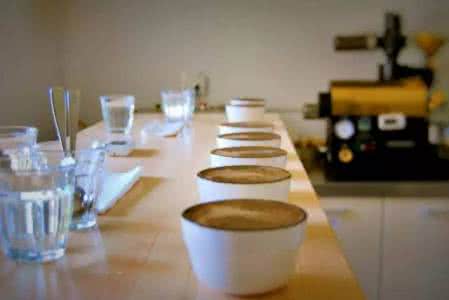Honey-treated coffee, like honey
Follow the caf é (Wechat official account vdailycom) and found that Beautiful Cafe opened a small shop of its own.
Honey-treated coffee, honey-like treatment-what a beautiful coffee term! This simple description can move people's hearts (after all, most people like honey), and honey-treated coffee has become more and more popular among consumers these days. There is no better description than "honey treatment" for this coffee processing formula: during drying, coffee beans are still accompanied by golden, sticky, sugary coffee pectin. In the process of washing, these pectin should be completely removed.
It is the Brazilians who make the honey-treated coffee known to the world, and they used to call it "pectin sun treatment". It is clear that Brazilian caffeine people want to maintain their successful experience in defining coffee terms in the past. Brazilians defined and promoted the "sun treatment", which means that the coffee beans are still in the whole coffee fruit during the drying process. Before that, this method was called "drying treatment" or "non-washing treatment". When I started the coffee industry more than 40 years ago, I often asked myself why Brazilians use the term "unwashed". Is their "unwashed" coffee very dirty? The coffee term is no longer used and replaced by "tanning". The term "tanning" sounds much bigger and represents a more finely processed type of coffee. No matter how good you are, you can't beat everyone, and this applies to the naming of the way coffee is handled. Central American countries have come up with an updated term "honey treatment" to define all coffee beans that are dried in the fruit, and the term "honey treatment" is widely popular in the world except Brazil. In this issue, there are 21 kinds of honey coffee from different places around the world, 7 from Costa Rica (one of which appears in this article), 5 Salvado (one of which appears in this article), 2 in Brazil, Nicaragua, Colombia, Sumatra, Rwanda, Thailand, Honduras and other countries.
The evolution of honey processing methods
In this issue, the honey-treated coffee from Costa Rica accounts for the majority. Although Brazil is a pioneer in honey processing, the term "honey treatment" and micro-batch refined honey coffee processing were first popular in Costa rica. In the innovation process of coffee microbatch processing in Costa rica, coffee growers use machines and equipment with new washing methods to process their own coffee, rather than buying coffee fruit to large coffee processing plants as in the past.
In the water washing method, mechanical equipment is used to remove pectin from the pulp and core of coffee, using only a small amount of water in the process. These machines can also be used for more elaborate "honey-treated" coffee processing. At present, there are all kinds of honey-treated caffeine-"black honey", "red honey", "yellow honey" and "white honey". In the treatment of black honey and red honey, coffee beans are dried with all or almost all of their pectin. The difference between the two lies in the drying speed of coffee: black honey dries more slowly than red honey. In the process of yellow honey treatment, a degumming machine is used to remove 20% Mel 50% coffee pectin before drying the coffee beans (the coffee sample treated with yellow honey was not received in this test). For honey treatment, almost all pectin will be removed in advance, leaving only about 10% of the pectin dried with coffee beans.
Subtle changes in treatment will affect the quality characteristics of coffee, so we can assume that the bright and transparent characteristics of white honey-treated coffee are closest to those of washed coffee; black honey and red honey (as mentioned above, almost all the pulp pectin of the coffee is retained) is closer to the traditional sun-treated coffee: it has a strong aroma of fruit, chocolate and wood fiber.
Cup test vs. Hypothetical
Another red honey, the Reunion Island Sol Naciente Costa Rica, has a more crisp lime citrus flavor.
Two tested black honey samples showed strong woody aroma characteristics, which are often shown in sun-dried coffee that has been slowly dried for a long time. The test score is 93. The black honey from Willoughby's Costa Rica El Puente Cerro Verde is full of vitality and without any flavor defects, high cleanliness, complex aroma, slightly irritating aroma and high sweetness. The elaborate recipe of black honey has created such a quality characteristic of coffee.
Further classification of the test results will be very complicated and cumbersome, and more than half of the coffee bean samples tested do not clearly indicate which treatment method is used. although the information obtained from the test results can be summarized as "honey treatment" and used in this test report. For example, El Salvador Fincal El Pozo with high flavor complexity and PT's Coko Rwanda Honey with strong origin style, these two kinds of coffee are simply marked as "honey treatment" without further detailed treatment and flavor introduction.
Charming and fickle
When we tested 21 honey-treated coffee samples, all the previous sporadic experience and knowledge helped us to make a general summary of honey-treated coffee: we perceive that the most important feature of honey-treated coffee is its softness, unpredictable flavor complexity and complexity. The subtle changes we perceived when we tested a group of honey to treat coffee were more obvious than when we tested a group of washed coffee. Except for 2 branches with a single plain flavor.
The difference between black honey coffee and tested honey-treated coffee is so subtle and fascinating that it is difficult to express it in words.
There is no doubt that the way of treatment is directly related to the change of flavor. How much pectin pulp is removed before drying, and the control of the details of the drying process are all factors that affect the flavor. All in all, the four samples with the highest score (93 points) showed natural and pure sweetness, fine changes in flavor and taste, smooth and sticky taste, all of which benefited from honey processing. The next level (6 caffeine samples with a score of 91) also showed a fine and fascinating change brought about by honey processing: woody spices mingled with flower and fruit aromas. For example, in a cup of coffee, you can detect subtle
The test results confirm our hypothesis to some extent. Equator Costa Rica El Aguacate honey with a score of 93 was the cleanest and brightest of the 10 coffees tested. At the same time, the cup test characteristics of two red honey, the Magnolia Costa Rica Esnider Rodriguez and the Manzanita El Salvador Loma La Loria reflect the influence of the change of treatment: the aroma of flower and wood fiber are intertwined with the flavor of brandy fermentation.
Honey treatment and producing area
The limited degree and range of test results show that the honey processing method enriches the unique characteristics and unpredictable complexity of coffee flavor compared with water washing treatment. This is not to say that honey processing is better than washing processing. For example, in producing areas such as Rwanda and Sumatra, the local traditional processing methods create the uniqueness of the coffee flavor. Delicate honey treatment can also create a different coffee flavor in the past. The specific situation in Brazil is different, as mentioned earlier in this article, people have been using terms such as "sun treatment" or "drying treatment" in Brazil. Compared with the traditional full-sun Brazilian coffee, the exquisite Brazilian honey-treated coffee does not get the corresponding attention of the world. Brazilian honey-treated coffee has a brighter and finer flavor, with more floral and fruit aromas than the traditional Brazilian sun-cured nut chocolate flavor.
In any case, if you prefer soft, floral and fruity coffee to traditional bright and well-balanced washed coffee, then honey-treated coffee from Costa Rica, Honduras, and Salva should suit you. For those who are addicted to coffee, they should also enjoy the fascinating coffee flavor brought about by the developing cooking technology of honey-treated coffee.
93 points
El Salvador Finca El Pozo Microlo Honey
Roaster "Propeller Coffee | Toronto, Canada
Aroma: 9
Acidity: 9
Alcohol thickness: 9
Flavor: 9
Yu Yun: 8
Property > Ataco, Apaneca- Ilamatepec, Ahuachap á n Department, El Salvador
Baking degree (caramelization tester) > > Medium (53max 70) medium degree
The price of 12 ounces is Canadian $22 (the coffee has been sold out and the baker Propeller hopes to buy more in 2017). It is the Alabica pacamara variety, which is a hybrid of giant beans maragogipe and pacas and belongs to the Guyu bourbon series. From Anibal Lunna Finca El Pozo. Roaster from Toronto, Canada, has been engaged in high-end boutique coffee roasting.
Balance, high sweetness, floral aroma, oak, dark chocolate, berries, cherries. Active acidity, honey taste, finish with aromas of oak and berries, dark chocolate.
The honey treatment method results in the flavor outline of this coffee and a pleasant sense of sweet and sour balance.
Roaster > > 35kg Loring Kestrel
The difficulty lies in how to properly bake the inside of these large beans thoroughly while avoiding damage to the soft outer layer of the coffee beans during roasting. In order to achieve the expected effect, the initial temperature of baking is faster (a small amount of beans, the temperature of beans is lower), the heating rate of the middle part slows down, and the beans are baked at the end of the explosion. Soft acidity, high sweetness, complex aroma, low and round taste. -- Jonathan Cox. Chief baker

Jonathan Cox. Chief baker
Important Notice :
前街咖啡 FrontStreet Coffee has moved to new addredd:
FrontStreet Coffee Address: 315,Donghua East Road,GuangZhou
Tel:020 38364473
- Prev

Several common brewing methods of coffee introduce the diagram of brewing method of coffee powder.
Following caf é comments (Wechat official account vdailycom) found that Beautiful Cafe opened a small shop of its own several common coffee brewing methods with the popularity of coffee culture, many friends have tasted the taste of freshly ground coffee. With many coffee utensils on the market, we can easily make good coffee and enjoy delicious coffee without leaving home. Actually, at home.
- Next

How to use the cup test to judge whether the coffee is good or bad?
Following Cafe Review (official Wechat account vdailycom) found that there is no right or wrong way of testing cups in Beautiful Cafe, which can help tasters feel the original flavor of coffee. It is often said that cup testing is a science, which needs a lot of professional knowledge to support. This is true, but it will not hinder people's enthusiasm for cup testing. The cup test is very simple, and there is no
Related
- What is the meaning of lactic acid fermentation with coffee bean treatment?
- How to judge the state of foam by sound?
- How does the latte pull out the unicorn pattern? Come to get for a little trick to improve the flower pull!
- Will flower pulling affect the taste of the latte?
- Do you know the history of coffee?
- The difference between honey treatment and sun washing what is raisin honey treatment?
- What kind of milk can a novice use to make coffee foam to keep the foam longer? The correct method and skills of milking tutorial sharing
- Why do washed coffee beans taste sour? Flavor characteristics of washed Coffee
- Introduction to the skill of how to practice the size and height of water injection around the circle of hand-brewed coffee
- How do beginners practice coffee flower drawing from scratch?

